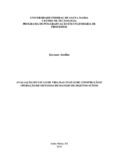| dc.creator | Azolim, Joceane | |
| dc.date.accessioned | 2021-04-16T11:06:49Z | |
| dc.date.available | 2021-04-16T11:06:49Z | |
| dc.date.issued | 2018-02-28 | |
| dc.identifier.uri | http://repositorio.ufsm.br/handle/1/20604 | |
| dc.description.abstract | The intensified swine production in Brazil brings the need to evaluate, develop and apply alternative management technologies that minimize negative impacts to the environment. Thus, the main objective of this study was to compare the environmental aspects and potential impacts of the construction and operation phase of three manure management systems (aerobic composting, anaerobic biodigesting and anaerobic pig slurry storage) from the swine industry using the methodology of Life Cycle Assessment (LCA). The LCA was performed through individual analysis and system comparison, using Simapro 8.2.3 software and the ReCipe method. The boundaries of the system included the collection of waste in the dwelling until its transformation into final product as fertilizer, and the functional unit was 1m³ of treated waste. Hence, in the individual analysis of the systems, the results showed that the most striking impact categories in the construction phase are marine ecotoxicity (ECM) and freshwater ecotoxicity (EAD) for the composting and biodigesting, and for the manure are the fossil depletion (DF) and ECM. In the composting and biodigesting systems the material with the greatest impact was steel, representing 98.73% and 98.73%, and 99.63% and 99.62%, respectively in each category. The high density polyethylene (HDPE) represented 89.28% in the DF category and 69.09% in the ECM category. When comparing these systems, both in terms of impact categories and in terms of damage categories, the results were equivalent, where the construction of the pig slurry storage presented the best environmental performance, followed by biodigesting and composting. In the phase of operation, the analysis of the Climate Change (CC) category showed that the "Compounds C, B and E" (elements related to gaseous emissions) were responsible for the major of impacts, representing 53.95%, 48.28% and 100 %, respectively. Finally, when comparing the operation phases (categories of impacts and damages), biodigesting for energy purposes was found with the best environmental performance, followed by the pig slurry storage, non-energetic biodigesting and composting. | eng |
| dc.language | por | por |
| dc.publisher | Universidade Federal de Santa Maria | por |
| dc.rights | Attribution-NonCommercial-NoDerivatives 4.0 International | * |
| dc.rights.uri | http://creativecommons.org/licenses/by-nc-nd/4.0/ | * |
| dc.subject | Fases da avaliação do ciclo de vida | por |
| dc.subject | Tratamento e manejo dos dejetos da suinocultura | por |
| dc.subject | Avaliação de impacto ambiental | por |
| dc.subject | Phases of life cycle assessment | eng |
| dc.subject | Treatment and management of swine manure | eng |
| dc.subject | Environmental impact assessment | por |
| dc.title | Avaliação do ciclo de vida das etapas de construção e operação de sistemas de manejo de dejetos suínos | por |
| dc.title.alternative | Life cycle assessment of stages of construction and operation of swine manure management systems | eng |
| dc.type | Dissertação | por |
| dc.description.resumo | Com a produção intensificada de suínos no Brasil, tem-se a necessidade de avaliar, desenvolver e aplicar tecnologias alternativas de manejo que minimizem os impactos negativos ao meio ambiente. Dessa forma, o objetivo principal deste estudo foi avaliar de forma comparativa os aspectos ambientais e impactos potenciais da fase de construção e operação de três sistemas de manejo de dejetos (compostagem aeróbia, biodigestor anaeróbio e esterqueira anaeróbia) oriundos da atividade de suinocultura, utilizando a metodologia de Avaliação do Ciclo de Vida (ACV). A ACV foi realizada por meio da análise individual e da comparação dos sistemas, utilizando o software Simapro® 8.2.3 e o método ReCipe. As fronteiras do sistema abrangeram o recolhimento do dejeto na habitação até a sua transformação em produto final como fertilizante, e a unidade funcional foi 1m3 de dejeto tratado. Sendo assim, na análise individual dos sistemas, os resultados mostraram que as categorias de impacto mais impactantes na fase de construção são a ecotoxicidade marinha (ECM) e a ecotoxicidade de água doce (EAD) para a composteira e o biodigestor, e para a esterqueira são a depleção fóssil (DF) e ECM. No sistema por compostagem e biodigestão, o material com maior impacto foi o aço, representando 98,73% e 98,73%, e 99,63% e 99,62% nestas categorias. E no sistema por esterqueira foi o Polietileno de Alta Densidade (PEAD), representando 89,28% na categoria DF e 69,09% na categoria ECM. Na comparação entre os sistemas, tanto em termos de categorias de impacto, quanto em termos de categorias de danos, os resultados foram equivalentes, onde a construção da esterqueira apresentou o melhor desempenho ambiental, seguido do biodigestor e da compostagem. Na fase de operação, a análise da categoria Mudanças Climáticas (MC) mostrou que os “Compostos C, B e E” (elementos relacionados as emissões gasosas) foram responsáveis pela maioria dos impactos, representando 53,95%, 48,28% e 100%, respectivamente. Por fim, na comparação da fase de operação (categorias de impactos e danos), o biodigestor com fins energéticos revelou o melhor desempenho ambiental, seguido da esterqueira, biodigestor sem fins energéticos e compostagem. | por |
| dc.contributor.advisor1 | Hoffmann, Ronaldo | |
| dc.contributor.advisor1Lattes | http://lattes.cnpq.br/4625067103734943 | por |
| dc.contributor.referee1 | Simioni, Flávio José | |
| dc.contributor.referee1Lattes | XXXXXXXXXXXXXXX | por |
| dc.contributor.referee2 | Carissimi, Elvis | |
| dc.contributor.referee2Lattes | XXXXXXXXXXXXXX | por |
| dc.creator.Lattes | http://lattes.cnpq.br/0559508106346028 | por |
| dc.publisher.country | Brasil | por |
| dc.publisher.department | Engenharia de Processos | por |
| dc.publisher.initials | UFSM | por |
| dc.publisher.program | Programa de Pós-Graduação em Engenharia de Processos | por |
| dc.subject.cnpq | CNPQ::ENGENHARIAS | por |
| dc.publisher.unidade | Centro de Tecnologia | por |



